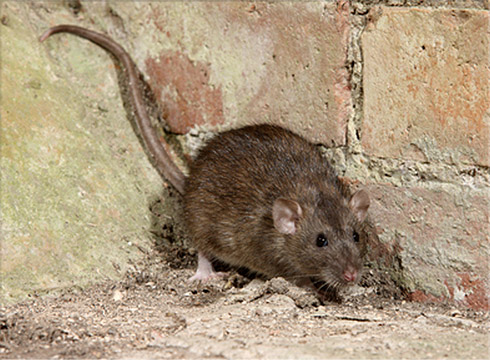
About The Pest
You might not see them, but you’ll know when Norway rats have moved in. Scratching in the walls, chewed corners, and droppings behind appliances are just a few of the warning signs. In New England, these rodents are a year-round problem, made worse by dense neighborhoods, aging infrastructure, and seasonal shifts that push pests indoors. Nowhere is safe, with both homeowners and businesses a potential target. Either way, a rat sighting can be troubling because a few rats can quickly become an infestation when the conditions are right.
What is a Norway Rat?
The Norway rat (Rattus norvegicus) is a large, stocky rodent often living in close contact with people. Unlike house mice, Norway rats need daily access to water and prefer to nest in lower levels like basements and crawl spaces. They're powerful burrowers and excellent swimmers, capable of making their way into homes through small openings or damaged vents. Their ability to adapt quickly to human environments makes them a challenging pest to control.
About The Pest
Originally introduced from Asia, the Norway rat gets its name from a historical misunderstanding. Early naturalists mistakenly believed the species came from Norway or Scandinavia because it was first observed in European ports, including Norway, during its spread. In reality, Norway rats originated in northern China and Mongolia and have since spread worldwide. These rodents are much larger than mice and have small ears, small eyes, and shorter tails. They are generally active at night and move indoors in the fall, when outdoor food is harder to find.
Norway rats are persistent and can chew through wood, plastic, and even soft metals to obtain food or water. Social by nature, they build networks of burrows close to one another, along riverbanks, near garbage, in woodpiles, or under slabs. They frequently nest in cluttered basements, garages, or undisturbed storage areas. A hole the size of a quarter is all they need to get inside.
Their gnawing can damage walls, pipes, and wiring when they infest properties. They also create a health risk by carrying bacteria and parasites. Diseases linked to Norway rats include jaundice, salmonellosis, trichinosis, and rat-bite fever. Their droppings and urine can contaminate food and bring fleas indoors, adding another layer of concern.
Norway Rat Characteristics
Adult Norway rats typically measure between 13 and 18 inches in length from nose to tail. Their bodies are thick with brownish-gray fur, and they have blunt noses, small ears, and long, scaly tails. One of the key characteristics of Norway rats is their strong teeth, which grow continuously and drive their constant gnawing behavior. This chewing helps them access food, water, or nesting areas, but can also damage electrical wiring, insulation, and plumbing. Their droppings are capsule-shaped and dark, often found near food sources or along baseboards. They leave greasy rub marks along frequently traveled paths that can create a slip hazard on smooth or polished floors.
Norway Rat Facts
Here are some helpful Norway rat facts you should know about:
- They reach maturity in just two to three months and can produce up to six litters a year, each with 6–12 pups.
- Norway rats are omnivores, meaning they’ll eat almost anything but prefer grains, meat, and pet food.
- They are most active at night and tend to follow the same paths between their nest and food sources.
- Their sense of smell is excellent, and they use scent trails to navigate and communicate.
- They can contaminate food and surfaces with urine, feces, and fur, increasing the risk of disease transmission.
Concerned about rats on your property? Contact the professionals at JP Pest Services for expert advice and humane rat removal solutions.
Seasonality
Norway rats remain active year-round, with increased activity in fall and winter. However, you may notice more rat activity in the fall and winter. As outdoor temperatures cool, rats seek warmth and consistent food sources indoors. Burrows and nests may appear near buildings or under decks, and sightings may increase around garbage areas. Year-round rat control is important to reduce the risk of an infestation before it begins.
Why Are Norway Rats A Pest?
The Norway rat is a pest because it causes property damage and is a health risk. Their gnawing can weaken building structures, destroy stored items, and spark electrical fires. More concerning is their role in spreading disease. Norway rats are known to carry harmful bacteria and parasites that can affect both people and pets. Through droppings, urine, and bites, they can contaminate surfaces and food. The presence of rats often draws in secondary pests like fleas, increasing the chance of additional infestations. Because they breed rapidly and are difficult to trap or remove completely, it's best to work with professionals like us for efficient, long-term rat control.
Frequently Asked Questions
What Is A Norway Rat And What Are Its Key Traits?
The Norway rat is a large, brownish rodent with a blunt nose and long tail. It’s known for strong gnawing, builds nests in low, dark places, and can enter homes through gaps the size of a quarter. Their ability to survive in various conditions makes them one of the most common rodents in the region.
Why Are Norway Rats Considered Pests And When Are They Most Active?
Norway rats are pests because they damage property by gnawing on structures and wiring, and they can spread diseases through their droppings and urine. They’re active all year but are most commonly noticed in colder months when they move indoors seeking food and warmth.
How Can I Prevent Norway Rat Infestations?
Preventing Norway rat infestations involves removing food and water sources, sealing entry points such as gaps around pipes and vents, and maintaining clean, clutter-free spaces around your property. Regular inspections and prompt action at the first signs of activity are crucial. For comprehensive prevention and removal, contact the experts at JP Pest Services.
